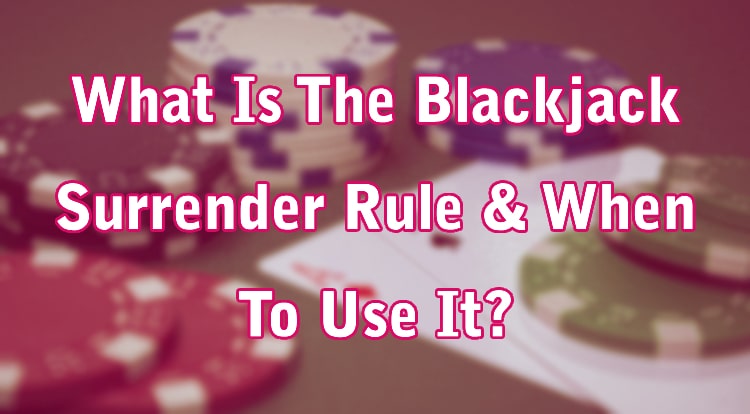
One of the lesser-known moves in blackjack that can drastically affect the outcome of your game is the 'Surrender' rule. Although not often employed by many players, understanding its implications and knowing when to use it can drastically enhance your playing strategy and potentially lead to more wins.
What Does Surrender Mean In Blackjack?
In the game of blackjack, 'surrender' refers to an option provided to players, allowing them to forfeit their hand after the initial deal if they believe their chances of winning are not promising. When a player decides to surrender, they lose half of their original bet and their hand is removed from the game immediately.
This option offers players an opportunity to mitigate their losses in situations where they hold a weak hand. However, it is important to note that the option to surrender is not available in all blackjack games and varies depending on the specific rules of the casino or the online platform.
The surrender rule can be especially beneficial if used strategically and at the right time. The next sections will delve deeper into the types of surrender and when it is optimal to use this gameplay strategy.
Late Surrender VS Early Surrender In Blackjack
The surrender rule in blackjack can be divided into two main categories: late surrender and early surrender.
Late Surrender
In the case of late surrender, the option to surrender is only available to the player after the dealer has checked their hole card (the card dealt face down) for blackjack. If the dealer's hand is not a blackjack, the player can proceed to surrender and forfeit half of their original bet.
Early Surrender
Early surrender allows the player to surrender their hand before the dealer checks for blackjack. This variant is more beneficial to the player as it provides an opportunity to exit the game early when facing a potential dealer blackjack. However, due to its player-friendly nature, casinos often compensate by tweaking other rules to maintain the house advantage.
When To Surrender In Blackjack
To make the most of the surrender rule, it's essential to know when to use it. The optimal time to surrender is when your chances of winning the hand are less than one out of four, meaning the odds are clearly against you.
The general consensus among blackjack strategists recommends surrendering in the following situations:
- When you have a hard 16 (excluding a pair of 8s), and the dealer shows a 9, 10, or Ace.
- When you have a hard 15, and the dealer shows a 10.
These instances reflect scenarios where your potential losses from playing the hand to conclusion are expected to be greater than 50% of your original bet, making surrender the most optimal decision.
Is Surrender Different From Insurance?
While both surrender and insurance are strategic options available in blackjack, they serve different purposes and should not be confused.
Insurance is a side bet offered when the dealer shows an Ace, allowing players to protect themselves against a potential dealer's blackjack. If the dealer indeed has a blackjack, the insurance bet pays 2:1, effectively compensating for the loss of the original bet.
On the other hand, surrender is a strategic decision made based on the strength of the player's hand in comparison to the dealer's upcard, allowing the player to forfeit their hand and recover half of their original bet.
Is Blackjack Surrender a Good Bet?
When used strategically, the surrender rule can indeed be a good bet. It provides an opportunity to minimise losses in situations where the odds are significantly against the player. However, one must be well-versed in blackjack strategy to accurately determine when surrender is the most advantageous option.
It's also important to remember that it isn't a standardised rule in blackjack, so it may not be available in some games. Check the rules of the specific blackjack game before playing so you know what to expect.
Which Hands To Surrender In Blackjack
The decision to surrender should be based on the composition of your hand and the dealer's upcard. As mentioned earlier, it is generally recommended to surrender hard 15 when the dealer shows a 10 and hard surrender 16 when the dealer shows a 9, 10, or Ace.
However, the player should also consider other factors, such as the number of decks used in the game, the dealer's rules for hitting or standing on soft 17, and the specific rules of the game variant.
What Is The Hand Signal For Surrender In Blackjack?
In a live casino setting, players need to use a specific hand signal to indicate their intention to surrender. This is usually done by drawing a horizontal line behind the bet with your index finger while verbally announcing "surrender".
However, the specific hand signal can vary between casinos, and it's always a good idea to ask the dealer about the proper etiquette.
In online blackjack games, a button is usually provided for the surrender option, making the process straightforward and hassle-free.
Conclusion
The surrender rule in blackjack, though often overlooked, can be a powerful move in the player's arsenal. By knowing when to surrender, players can effectively mitigate their potential losses and improve their overall game strategy. Whether you're playing online or at a physical casino, understanding the nuances of surrender can certainly give you an edge in the game of blackjack.
However, it's important to remember that it is not available in all blackjack games. Please gamble responsibly, and remember that blackjack is still a game of chance with no guarantees of winning.
*All values (Bet Levels, Maximum Wins, etc.) mentioned in relation to this game are subject to change at any time. Game features mentioned may not be available in some jurisdictions.
